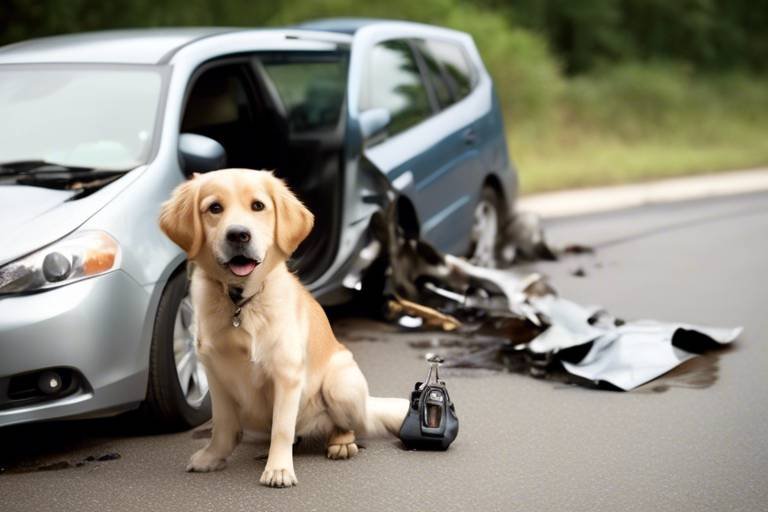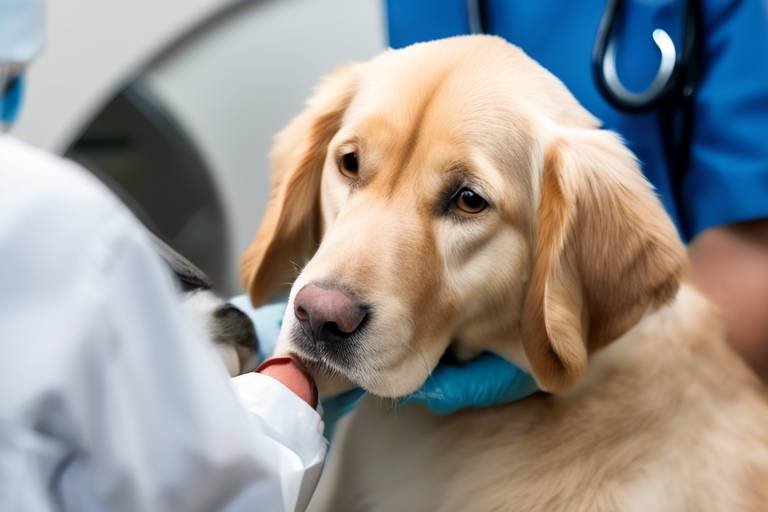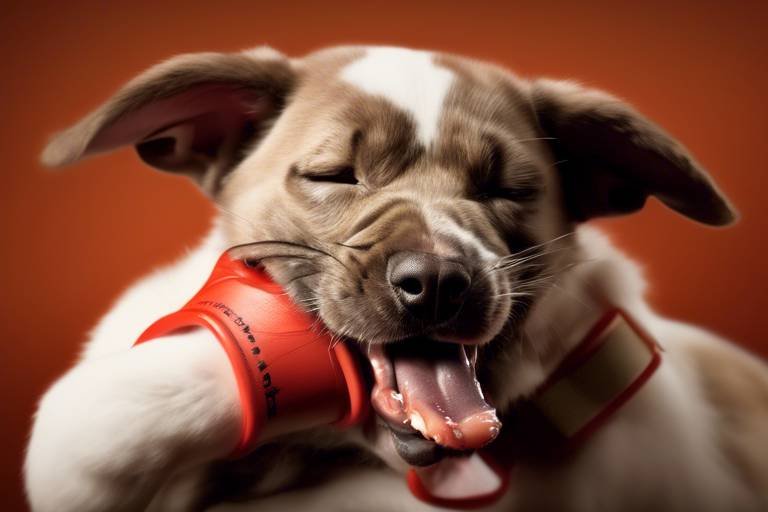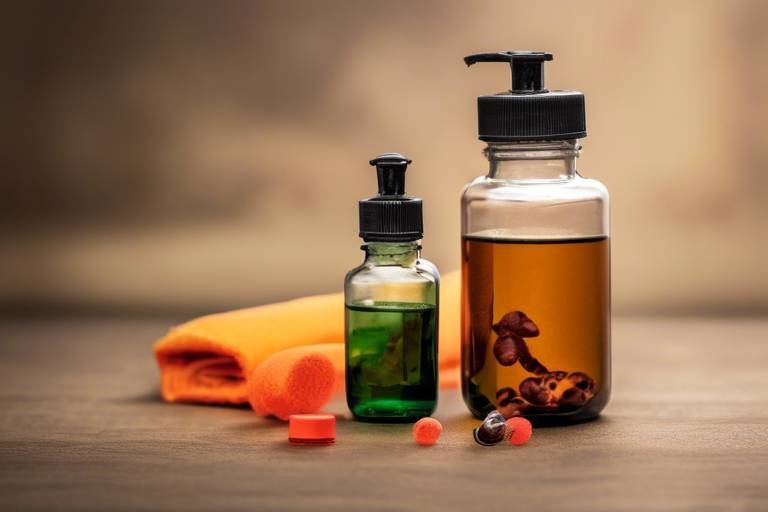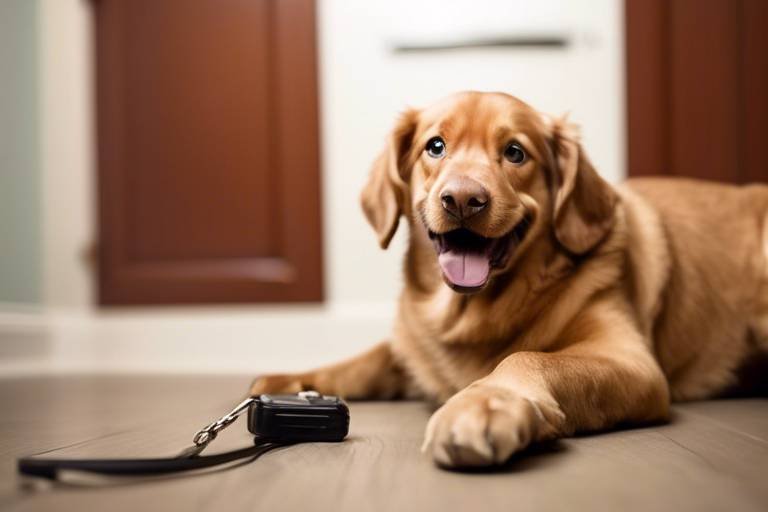How to Protect Your Pet from Car Accidents
Traveling with your furry friend can be one of the most enjoyable experiences, but it also comes with its own set of challenges, especially when it comes to safety. Just like we buckle up for protection, our pets need that same level of care to ensure their safety during car rides. The last thing you want is for your beloved pet to be at risk of injury or worse in the event of an accident. This article explores various strategies and tips to ensure your pet's safety while traveling in a vehicle, emphasizing preventive measures and responsible pet ownership. So, let’s dive into the world of pet travel safety, where awareness and preparation can make all the difference.
Recognizing the dangers pets face in vehicles is crucial. Did you know that according to a study by the American Automobile Association (AAA), nearly 30% of pet owners admit to being distracted by their pets while driving? This distraction can lead to serious accidents, not just for pets but for everyone in the vehicle. Common scenarios that lead to accidents involving pets include:
- Unrestrained pets jumping around the car.
- Pets leaning out of windows, risking falls or injuries.
- Sudden stops causing pets to be thrown around inside the vehicle.
These statistics highlight the importance of awareness. As a responsible pet owner, it’s your duty to ensure your pet is safe and secure while on the road. Understanding these risks is the first step toward implementing effective safety measures.
Using appropriate restraint systems is vital for pet safety. Just like seat belts are essential for humans, pets also need a secure way to travel. There are various types of restraint systems designed specifically for pets, including harnesses, crates, and seat belts. Each option has its own set of advantages, and choosing the right one can significantly reduce the risk of injury during travel.
Selecting a harness that fits well and is designed for car travel can make a significant difference. A quality harness not only keeps your pet secure but also prevents them from becoming a projectile in the event of a sudden stop. Look for harnesses that are crash-tested and designed specifically for car use. The right harness should have the following features:
- Adjustable straps for a snug fit.
- Durable materials that withstand wear and tear.
- Comfortable padding to prevent chafing.
Understanding your pet's size and body type is essential for choosing the right harness. A harness that is too loose can allow your pet to escape, while one that is too tight can cause discomfort or injury. To measure your pet accurately, follow these steps:
- Measure the circumference of your pet’s chest just behind the front legs.
- Measure the length from the base of the neck to the base of the tail.
- Compare these measurements with the sizing chart provided by the harness manufacturer.
Taking the time to get these measurements right will ensure you select a harness that fits perfectly, allowing for safe and comfortable travel.
The material of the harness affects its safety and longevity. Look for harnesses made from high-quality, durable materials that can withstand the wear and tear of regular use. Nylon and polyester are popular choices due to their strength and resistance to fraying. Additionally, consider harnesses with reflective materials for better visibility during nighttime travel.
Crate training can be an effective way to keep pets safe during travel. A well-trained pet will view their crate as a safe haven rather than a punishment. The benefits of using a crate include:
- Providing a secure space during travel.
- Reducing anxiety for pets who may feel overwhelmed in a moving vehicle.
- Preventing distractions for the driver.
To successfully crate train your pet, start by making the crate a comfortable and inviting space with their favorite blanket and toys. Gradually introduce them to the crate during short trips before embarking on longer journeys.
Implementing safe travel practices is vital for protecting your pet. Before heading out, make sure your pet is acclimated to car rides. This means taking the time to introduce them to the vehicle gradually. Start with short trips around the block, and reward them with treats and praise to create positive associations.
Gradually introducing your pet to car rides can help reduce anxiety. Here are some tips to make your pet comfortable with traveling in a vehicle:
- Use their favorite toys or blankets to make the car feel familiar.
- Keep the car well-ventilated and at a comfortable temperature.
- Take breaks during long trips for bathroom and exercise needs.
Certain behaviors can increase the risk of accidents. Avoid allowing your pet to stick their head out of the window, as this can lead to serious injuries. Additionally, never let your pet roam freely in the car, as this can distract the driver and lead to dangerous situations. Always prioritize your pet's safety and your own by keeping them secured in their harness or crate.
Being prepared for emergencies is essential when traveling with pets. Accidents can happen, and knowing how to respond can make a world of difference. Always keep a pet-specific first aid kit in your vehicle, and familiarize yourself with basic first aid procedures for pets.
Having a pet-specific first aid kit on hand can be lifesaving. Essential items to include in your kit are:
- Gauze and bandages
- Antiseptic wipes
- Pet-safe pain relievers
- A muzzle (for injured pets)
Knowing how to use these items effectively can help you manage minor injuries while on the road.
Knowing where to find emergency veterinary services is crucial for pet owners. Before embarking on a long trip, research local veterinary clinics along your route. Keep a list of emergency contacts handy, including the nearest animal hospitals and a 24-hour emergency vet hotline. Being prepared can ease your mind and ensure your pet receives prompt care if needed.
Q: Is it safe to let my pet ride in the back of a pickup truck?
A: No, it is not safe. Pets can easily be injured by sudden stops or bumps, and they are at risk of falling out. Always secure your pet in the cab of the vehicle.
Q: What should I do if my pet gets car sick?
A: Consult your veterinarian for advice. They may recommend anti-nausea medication or tips to acclimate your pet to car rides slowly.
Q: Can I use a regular seatbelt for my pet?
A: While some seatbelt attachments are designed for pets, it’s essential to use a harness specifically made for car travel to ensure maximum safety.

Understanding the Risks
When it comes to traveling with our furry friends, understanding the risks involved is the first step towards ensuring their safety. Did you know that according to the American Automobile Association (AAA), over 30,000 accidents each year are attributed to pets distracting their owners while driving? This staggering statistic highlights the importance of being aware of how our pets can inadvertently become a hazard on the road. Imagine driving with your beloved dog or cat, only for them to jump into your lap just as you’re about to make a turn—it's a scenario that could lead to serious consequences.
Moreover, pets can face a multitude of dangers when left unrestrained in a vehicle. In a sudden stop or collision, unrestrained pets can become projectiles, leading to severe injuries not only to themselves but also to human passengers. A study from the American Veterinary Medical Association (AVMA) indicates that pets involved in car accidents are at a higher risk of suffering from traumatic injuries, including broken bones and internal damage. The statistics are alarming, but they serve as a reminder of the importance of responsible pet ownership.
Common scenarios that lead to accidents involving pets include:
- Distracted Driving: Pets that roam freely can distract the driver, leading to accidents.
- Jumping Out of Windows: Many pets love to stick their heads out of the window, but this can be dangerous if they jump out or if debris hits them.
- Heat Stroke: Leaving pets in a hot car, even for a short time, can lead to heat exhaustion or stroke, which can be fatal.
It's essential to recognize these risks and take proactive measures to mitigate them. By being aware of these dangers, you can create a safer travel environment for your pets. As a responsible pet owner, it's your duty to ensure that your furry companions are not only comfortable but also secure during car rides. Remember, a little preparation can go a long way in preventing accidents and keeping your pets safe on the road.

Proper Restraint Systems
When it comes to traveling with your furry friends, ensuring their safety is of utmost importance. Just like we buckle up for our safety, our pets deserve the same level of protection. Proper restraint systems are not just a luxury; they are a necessity that can prevent serious injuries during car rides. Think of it this way: would you let your child roam freely in a moving vehicle? Of course not! The same logic applies to our pets.
There are various types of restraint systems available, each designed with your pet's safety in mind. These include harnesses, crates, and specialized seat belts. Choosing the right one can make a world of difference. For instance, a well-fitted harness can keep your pet securely in place, while a sturdy crate can provide a safe haven during travel. Understanding the options is key to making an informed decision.
Let’s break down the main types of restraint systems:
- Harnesses: These are designed to keep your pet secure without causing discomfort. They come in various styles and sizes to fit any breed.
- Crates: Crate training not only keeps your pet safe but can also help them feel secure during travel, reducing anxiety.
- Seat Belts: Specially designed seat belts for pets can be attached to your car's existing seat belt, providing a simple yet effective restraint.
Each of these systems has its own advantages, but the key is to ensure that whatever you choose fits your pet correctly. An ill-fitting harness or crate can lead to injury rather than prevent it. So, let’s delve deeper into what makes a good harness.
When selecting a harness, it’s essential to consider factors like size, fit, and material. A good harness should not only be easy to put on and take off but also sturdy enough to withstand any sudden movements. Additionally, look for a harness that distributes pressure evenly across your pet's body to avoid choking or injury.
To find the perfect harness, you need to measure your pet accurately. Start by measuring around your pet's chest, just behind the front legs, and then check the neck circumference. Most harnesses come with size charts, so use those as a guide. A snug fit is ideal, but it should allow for a finger to slide between the harness and your pet’s body. Remember, a harness that’s too loose can slip off, while one that’s too tight can cause discomfort.
The material of the harness plays a significant role in its effectiveness. Look for harnesses made from high-quality, durable materials that can withstand wear and tear. Nylon and polyester are popular choices due to their strength and resistance to fraying. Additionally, padded harnesses can offer extra comfort for your pet, making travel more enjoyable for them.
In summary, investing in a proper restraint system for your pet is crucial for their safety during car rides. Not only does it protect them, but it also gives you peace of mind while driving. Remember, the right choice can make all the difference in ensuring that your beloved companion travels safely.
Choosing the Right Harness
When it comes to ensuring the safety of your furry friend during car rides, selecting the right harness is absolutely crucial. A well-chosen harness can mean the difference between a safe journey and a potential disaster. But how do you know which harness is the best fit for your pet? It’s not just about grabbing the first one off the shelf; you need to consider several factors that cater specifically to your pet’s needs.
First and foremost, the fit of the harness is paramount. An ill-fitting harness can lead to discomfort and even injury in the event of a sudden stop or accident. To find the perfect fit, you should measure your pet’s chest and neck carefully. Generally, a harness should be snug enough to prevent your pet from wriggling out, but not so tight that it restricts movement or breathing. A good rule of thumb is to ensure that you can fit two fingers between the harness and your pet’s body.
Now, let’s talk about the design of the harness. There are various styles available, including those with padded straps, which provide additional comfort for your pet during long trips. Look for harnesses that distribute pressure evenly across the chest rather than the neck, as this can help prevent injuries. Remember, a harness that is designed specifically for car travel will often have features that standard walking harnesses lack, such as reinforced stitching or crash-tested ratings.
Another important aspect to consider is the material of the harness. You want something that is not only durable but also comfortable for your pet. Many high-quality harnesses are made from breathable materials that help keep your pet cool, especially during those warm summer drives. Additionally, consider the ease of cleaning; a harness that can be machine washed will save you time and hassle in the long run.
To help you visualize your options, here’s a quick comparison table of different types of harnesses:
| Type of Harness | Best For | Key Features |
|---|---|---|
| Standard Harness | Everyday use | Easy to put on, comfortable fit |
| Car Safety Harness | Traveling | Crash-tested, padded for comfort |
| Vest Harness | Small or elderly pets | Distributes weight evenly, reduces strain |
Lastly, don’t forget to read reviews and perhaps even ask your veterinarian for recommendations. Pets, like humans, come in all shapes and sizes, and what works for one might not work for another. By taking the time to choose the right harness, you’re not just investing in a piece of equipment; you’re investing in your pet’s safety and comfort during every adventure you share together.
- What size harness should I buy for my pet? Measure your pet's neck and chest to find the right size. Most harnesses come with a sizing chart to help you choose.
- Can I use a regular harness for car travel? It’s best to use a harness specifically designed for car travel, as these are crash-tested and provide better safety.
- How do I train my pet to wear a harness? Start by letting your pet sniff and explore the harness before putting it on. Gradually introduce it during short car rides to help them adjust.
Size and Fit Considerations
When it comes to choosing the right harness for your furry friend, size and fit are absolutely crucial. Just like us humans wouldn’t want to wear shoes that are too tight or too loose, our pets deserve the same comfort and safety. A harness that fits poorly can lead to discomfort, and worse, it can become a hazard during travel. So, how do you ensure you’re picking the perfect harness for your pet? It starts with understanding their size and body type.
First off, you’ll need to measure your pet accurately. This involves taking a few simple measurements: the neck circumference, the chest girth, and sometimes even the length of their body. Here’s a quick guide on how to measure:
| Measurement | How to Measure |
|---|---|
| Neck Circumference | Wrap a measuring tape around the base of the neck, where the collar would sit. |
| Chest Girth | Measure around the widest part of the chest, just behind the front legs. |
| Body Length | Measure from the base of the neck to the base of the tail. |
Once you have these measurements, compare them with the sizing chart provided by the harness manufacturer. Each brand may have slightly different sizing, so it’s essential to refer to their specific guidelines. A harness that is too tight can restrict movement and cause chafing, while one that is too loose may not keep your pet secure, allowing them to slip out during sudden stops or turns.
Moreover, consider your pet's body shape. For instance, a bulldog has a very different build compared to a greyhound. Some harnesses are designed for specific breeds or body types, which can enhance both comfort and safety. Additionally, if your pet is still growing, you might want to invest in an adjustable harness that can accommodate their growth, ensuring they remain secure as they get bigger.
Lastly, don’t forget to check the material and design of the harness. A well-designed harness will have padding in areas that come into contact with your pet’s body, preventing discomfort during longer trips. Always opt for durable materials that can withstand wear and tear, especially if your pet is an active one. Remember, a harness isn’t just a piece of equipment; it’s a vital part of their travel safety gear.
- How do I know if my pet's harness fits properly? A good fit means you can fit two fingers between the harness and your pet’s skin without it being too loose.
- Can I use a regular collar instead of a harness? While collars can be used for some pets, harnesses are generally safer for car travel as they distribute pressure across the chest.
- What if my pet doesn't like wearing a harness? Gradual acclimatization can help. Start by letting them wear it for short periods at home, rewarding them with treats to create a positive association.
Material and Durability
When it comes to choosing a harness for your pet, are two of the most critical factors to consider. After all, a harness is not just a fashion statement; it plays a pivotal role in ensuring your furry friend's safety during car rides. Think of it like selecting the right shoes for a marathon—if they’re not up to the task, the journey can turn painful or even dangerous.
First off, let’s talk about the different materials commonly used in pet harnesses. You’ll often find options like nylon, polyester, and even padded harnesses made from breathable mesh. Each material has its pros and cons:
| Material | Pros | Cons |
|---|---|---|
| Nylon | Durable, lightweight, and easy to clean | Can cause chafing if not padded |
| Polyester | Strong, resistant to stretching, and often comes in various colors | May not be as breathable as other materials |
| Mesh | Comfortable, breathable, and great for hot weather | Less durable than nylon or polyester |
Choosing a harness made from a durable material is essential because it will withstand the wear and tear of everyday use. Consider how active your pet is; if your dog is a high-energy breed that loves to jump around, you’ll want something that can handle that level of activity without fraying or breaking. A well-constructed harness should not only be tough but also comfortable. Look for options that feature padded straps or breathable materials to prevent discomfort during long car rides.
Moreover, always check the stitching and buckles. A harness may look great on the outside, but if the stitching is weak or the buckles are flimsy, it could fail when you need it most. It’s like having a fancy car with a cheap engine—looks good, but will it get you where you need to go safely? So, ensure that the harness you choose has reinforced seams and sturdy hardware.
In conclusion, investing in a high-quality harness made from durable materials is not just about aesthetics; it’s about ensuring your pet's safety and comfort during travel. A little research and attention to detail can go a long way in keeping your furry friend secure on the road.
- What type of harness is best for my pet? It depends on your pet’s size, activity level, and specific needs. Look for harnesses that provide a snug fit and are made from durable materials.
- How can I ensure the harness fits properly? Measure your pet’s girth and neck size, and refer to the manufacturer’s sizing chart to find the best fit.
- Are padded harnesses worth the investment? Yes! Padded harnesses can prevent chafing and discomfort, making them a great choice for long trips.
Crate Training for Safety
Crate training is not just a method for keeping your pet contained; it’s a vital safety measure that can protect your furry friend during car travels. Think of a crate as a cozy, secure den for your pet. It’s their personal space, a little sanctuary that can help them feel safe and calm, especially when the world outside is moving at high speeds. By introducing your pet to a crate, you’re not only providing them with a safe travel environment but also giving them a place they can associate with comfort and security.
To get started with crate training, the key is to make the crate a positive experience. Begin by letting your pet explore the crate at their own pace. You can place their favorite blanket or toy inside to entice them. It’s all about making the crate feel like a home away from home. Once your pet is comfortable entering the crate, you can gradually increase the amount of time they spend inside it, rewarding them with treats and praise. This process helps them associate the crate with good feelings, which is essential for successful training.
When it comes to traveling, a well-trained pet will be much less anxious. A crate provides a secure environment that minimizes distractions for the driver and protects your pet from sudden stops or sharp turns. However, it’s essential to choose the right crate. Look for one that is well-ventilated, sturdy, and appropriately sized for your pet. A crate that is too large may allow your pet to move around too much, potentially leading to injury, while one that is too small can cause discomfort.
Here are a few tips to keep in mind when crate training your pet for travel:
- Start crate training well before your travel date to ensure your pet is comfortable.
- Use positive reinforcement to encourage your pet to enter the crate willingly.
- Ensure the crate is secured in your vehicle to prevent it from sliding or tipping during transit.
- Never use the crate as a form of punishment; it should always be a safe haven.
In addition to safety, crate training can also help reduce car sickness in pets. By providing a stable environment, the crate can help your pet feel more secure and less prone to anxiety. Remember, patience is key. Each pet is different, and some may take longer to adjust than others. The goal is to create a positive association with the crate, making it a natural choice for travel.
Ultimately, crate training is about ensuring your pet's safety and comfort while traveling. With a little time and effort, you can transform the crate into a beloved space for your pet, making every journey a safe and enjoyable experience for both of you.
Q: How long should I leave my pet in the crate during travel?
A: It's best to take breaks every couple of hours to let your pet stretch and relieve themselves. Prolonged periods in the crate can be uncomfortable.
Q: Can I use a crate for my pet if they are not crate trained?
A: It's advisable to crate train your pet before travel. If they are not used to a crate, it may cause anxiety and stress during the journey.
Q: What if my pet becomes anxious in the crate?
A: Gradually acclimate your pet to the crate and consider using calming aids or consult your veterinarian for additional advice.
Q: Are there specific types of crates recommended for car travel?
A: Look for crash-tested crates designed specifically for vehicle use, which offer added safety features for your pet.

Safe Travel Practices
When it comes to ensuring your furry friend’s safety during car rides, implementing is absolutely essential. Imagine this: you’re driving down the road, the music is playing, and your pet is happily wagging their tail beside you. But wait! Have you considered how to make that experience as safe as possible? The truth is, many pet owners overlook the importance of preparing their pets for travel, which can lead to anxiety and even accidents. So, let’s dive into some effective strategies to keep your pet safe and sound while you’re on the go!
First and foremost, acclimating your pet to the car is crucial. Just like humans, pets can experience anxiety when faced with new environments. Start by allowing your pet to explore the car while it’s parked. Let them sniff around, hop in and out, and get comfortable with the space. Gradually introduce short trips around the block before embarking on longer journeys. This gradual exposure will help your pet associate car rides with positive experiences, making them more relaxed and less prone to anxiety during travel.
Now, let’s talk about some common mistakes pet owners make while traveling. For instance, allowing your pet to roam freely in the car can be incredibly dangerous. Not only does it distract the driver, but it also puts your pet at risk of injury in the event of a sudden stop or accident. Instead, make sure your pet is securely restrained using a proper harness or crate. This keeps them safe and ensures that they stay in one place, minimizing distractions.
Another mistake is neglecting to take breaks during long trips. Just like us, pets need to stretch their legs, hydrate, and relieve themselves. Plan your travel itinerary to include regular stops, ideally every couple of hours. This will not only keep your pet comfortable but also prevent restlessness and anxiety. During these breaks, make sure to keep your pet on a leash to avoid any potential escapes or accidents.
When it comes to feeding your pet before a trip, timing is everything. It’s best to avoid feeding them a large meal right before hitting the road. Instead, opt for a light snack a few hours prior to your journey. This can help prevent motion sickness and keep your pet feeling comfortable throughout the ride. Remember, a happy pet makes for a happy trip!
Lastly, always keep a pet travel kit handy. This kit should include essentials like water, a travel bowl, waste bags, and any medications your pet may require. Having these items readily available can make your journey smoother and more enjoyable for both you and your pet. Don’t forget to also pack their favorite toy or blanket to provide a sense of familiarity and comfort during the ride.
In conclusion, safe travel practices are not just about following rules; they’re about ensuring your pet feels secure and happy while you’re on the road. By taking the time to prepare and implement these strategies, you’ll not only protect your furry friend but also create cherished memories during your travels together.
- What is the safest way to travel with my pet? Using a pet seatbelt or crate is the safest option. It keeps your pet secure and minimizes distractions while driving.
- How can I help my pet overcome car anxiety? Gradually acclimate them to the car with short trips and positive reinforcement, like treats and praise.
- Is it safe to leave my pet in the car for a short period? No, it’s not safe. Temperatures can rise quickly, leading to heatstroke or other dangers.
- What should I include in a pet travel kit? Essential items include water, a travel bowl, waste bags, medications, and a familiar toy or blanket.
Acclimating Your Pet
Getting your furry friend comfortable with car rides is essential for their safety and your peace of mind. Just like humans, pets can experience anxiety when faced with new experiences, and a car ride can be one of those situations that leaves them feeling uneasy. So, how do you make the car a happy place for your pet? The key is to acclimate them gradually. Start by allowing them to explore the vehicle while it’s parked. Open the doors, let them sniff around, and even toss in a favorite toy or blanket to create a sense of familiarity. Think of it like introducing a new friend; you wouldn’t rush things, right?
Once your pet seems comfortable with the vehicle, it’s time to take baby steps. Start with short trips around the block. Keep the mood light and positive. Bring along some treats and praise them when they behave well. If your pet shows signs of anxiety—like whining or excessive panting—don’t panic. Just take a break and let them adjust. It’s important to remember that patience is key. You wouldn’t expect a child to enjoy a long road trip without some practice, so why should your pet be any different?
As you continue to take your pet on short rides, gradually increase the length of your trips. This helps them build a positive association with the car. During these rides, try to maintain a calm atmosphere. Use soothing music or talk to them gently. If you notice that they are still hesitant, consider using a calming spray or a natural remedy designed for pets to help ease their nerves.
Another important factor in acclimating your pet is the use of proper restraint systems. This not only keeps them safe but also helps them feel secure. A well-fitted harness or crate can make a world of difference. Think of it as their cozy little nook in a moving world. The more secure they feel, the better they’ll adapt to the experience.
Finally, don’t forget to reward your pet after each successful trip. It could be a simple treat or extra playtime at the park. This reinforces the idea that car rides can be fun and rewarding. Over time, your pet will look forward to these adventures instead of dreading them. Remember, the goal is to create a positive connection between your pet and car travel, making it a stress-free experience for both of you!
- How long should I wait before taking my pet on a longer car ride?
Start with short trips and gradually increase the duration as your pet becomes more comfortable. - What should I do if my pet gets car sick?
Consult your veterinarian for advice on managing car sickness, which may include medication or behavioral techniques. - Can I use a regular dog harness for car travel?
It’s best to use a harness specifically designed for car travel to ensure maximum safety and security.
What to Avoid During Travel
When it comes to traveling with your furry friend, it's not just about buckling up and hitting the road. There are a multitude of common mistakes that pet owners make, which can significantly increase the risk of accidents or distress for your pet. For instance, one of the biggest blunders is allowing your pet to roam freely in the vehicle. Picture this: you're driving down the highway, and suddenly, your dog decides to jump into your lap. Not only is this a distraction, but it can also lead to serious injuries for both of you in the event of a sudden stop. Instead, make sure your pet is properly secured in a harness, crate, or seatbelt designed specifically for pets.
Another critical aspect to consider is the temperature inside the vehicle. Leaving your pet in a hot car, even for a short period, can be deadly. On a warm day, the temperature inside a parked car can soar to dangerous levels in just minutes. Always keep an eye on the weather and ensure your pet is comfortable, especially during the summer months. If you need to make a quick stop, it's better to take your pet with you or ensure that the vehicle is well-ventilated and shaded.
Additionally, distractions can come in many forms. Whether it's a phone call, a snack, or even adjusting the radio, taking your attention away from the road can have dire consequences. It's essential to keep your focus on driving and to avoid engaging in activities that could divert your attention. If you need to address something, pull over safely before doing so.
Moreover, feeding your pet right before a trip can lead to motion sickness. Just like humans, pets can experience nausea while traveling. To prevent this, try to feed your pet a few hours before you hit the road. This way, their stomach has time to settle, making for a more pleasant journey for everyone involved.
Lastly, don't forget to plan for frequent breaks. Long stretches of travel can be exhausting for pets, so it's important to stop every couple of hours to allow them to stretch their legs, relieve themselves, and hydrate. These breaks not only help keep your pet comfortable but also reduce the chances of anxiety and restlessness during the trip.
In summary, being aware of what to avoid during travel can make a world of difference in ensuring a safe and enjoyable experience for both you and your pet. By steering clear of distractions, managing the temperature, and planning your journey thoughtfully, you can create a travel environment that prioritizes your pet's well-being.
- What is the safest way to transport my pet in a car? Using a pet-specific harness, crate, or seatbelt is the safest option.
- Can I leave my pet alone in the car for a short time? It's best to avoid leaving your pet alone in a car, especially in warm weather.
- How can I prevent my pet from getting car sick? Feed your pet a few hours before traveling and consider using calming aids if necessary.
- What should I include in a pet travel kit? Essentials include water, food, bowls, a leash, waste bags, and a first aid kit.

Emergency Preparedness
When it comes to traveling with your beloved pet, being prepared for emergencies is not just a good idea; it's essential. Imagine driving down the highway, your favorite tunes playing, and suddenly, a tire blows out. In that moment, the last thing you want to worry about is how to keep your furry friend safe. That's why having a solid emergency plan is crucial. This section will guide you through the necessary steps to take in case of an accident and how to ensure your pet's well-being in those unexpected moments.
First and foremost, it's vital to have a well-stocked pet-specific first aid kit readily available in your vehicle. Think of it as your pet's safety net. Just like how we humans have our go-to first aid supplies, your pet deserves the same level of care. A typical first aid kit for pets should include items such as:
- Adhesive bandages
- Gauze pads and tape
- Antiseptic wipes
- Hydrogen peroxide (for cleaning wounds)
- Scissors (for cutting tape or gauze)
- Instant cold packs
- Thermometer (specifically for pets)
- Emergency contact numbers (vets, poison control)
Having these essentials on hand can be lifesaving. For instance, if your pet gets a minor cut during an unexpected stop, you can quickly clean and bandage it, reducing the risk of infection. But remember, a first aid kit is only effective if you know how to use the items within it. Consider taking a pet first aid course, so you’re not left scrambling when the moment arises.
Next, let's talk about knowing where to find emergency veterinary services. Picture this: you’re in an unfamiliar area, and your pet has an accident. Panic sets in, and you have no clue where the nearest vet is. This scenario can be avoided with a little preparation. Before hitting the road, do some research on veterinary clinics along your route. Make a list of their contact information and addresses, and keep it handy. You can even use mobile apps that help locate nearby veterinary services in case of an emergency. This proactive approach can save valuable time when every second counts.
Additionally, it's wise to keep a printed copy of your pet's medical history in your glove compartment. This document should include vaccination records, any chronic health issues, and medications your pet is currently taking. In an emergency, having this information readily available can help veterinarians make informed decisions about your pet's care.
Lastly, don’t forget to have a plan for your pet's comfort and safety during an emergency. Just like us, pets can feel stressed and anxious in unfamiliar situations. Consider bringing along a favorite toy or blanket that smells like home. This small gesture can provide comfort and reassurance to your pet when they need it most.
In summary, being prepared for emergencies while traveling with your pet is all about having the right tools and information at your fingertips. By equipping yourself with a pet first aid kit, knowing where to find emergency veterinary services, and keeping your pet's medical history close, you can ensure that you're ready for anything the road throws your way. Remember, a little preparation goes a long way in keeping your furry friend safe and sound.
Q: What should I include in my pet's first aid kit?
A: Essential items include adhesive bandages, gauze pads, antiseptic wipes, scissors, and emergency contact numbers.
Q: How can I find emergency veterinary services while traveling?
A: Research veterinary clinics along your route before your trip, and consider using mobile apps to locate nearby services in case of emergencies.
Q: Why is acclimating my pet to car rides important?
A: Gradual acclimation helps reduce anxiety and makes traveling a more pleasant experience for your pet.
First Aid Kits for Pets
When it comes to ensuring the safety and health of our furry companions, having a well-stocked first aid kit specifically designed for pets is absolutely essential. Just like with humans, emergencies can happen at any time, and being prepared can make all the difference. Imagine being on a road trip, and your pet suddenly has an allergic reaction or gets injured. Wouldn't you want to be ready to handle the situation immediately? A pet first aid kit can help you manage these unexpected incidents effectively.
Your pet's first aid kit should include a variety of items that cater to their unique needs. Here are some essential components you should consider including:
- Gauze and Bandages: These are crucial for treating cuts and scrapes. Make sure to have various sizes to accommodate different injuries.
- Antiseptic Wipes or Solution: Keeping wounds clean is vital to prevent infection.
- Adhesive Tape: This helps secure bandages in place and is useful for wrapping injuries.
- Scissors: A pair of blunt-end scissors can be handy for cutting bandages or gauze.
- Thermometer: A pet-specific thermometer allows you to monitor your pet's temperature, which can be a key indicator of health issues.
- Emergency Contact Information: Include numbers for your veterinarian and nearby emergency animal hospitals.
In addition to these basic supplies, consider adding some other items that could be lifesaving. For example, a pair of tweezers can help remove splinters or ticks, while a muzzle can prevent your pet from biting when they're in pain. Don't forget to include a pet first aid manual or guide, as it can provide valuable instructions on how to handle various emergencies.
It's also a good idea to periodically check the contents of your first aid kit to ensure nothing has expired or been used up. Just like your own medicine cabinet, a first aid kit is only effective if it’s stocked and ready to go. Make it a habit to review your kit every few months and replace any items as needed.
Lastly, remember that while a first aid kit is an important tool, it should not replace professional veterinary care. In case of a serious injury or illness, always seek immediate help from a veterinarian. Your pet relies on you for their safety, so being prepared with a first aid kit is just one more way to show your love and responsibility as a pet owner.
Q: What should I include in a pet first aid kit?
A: Essential items include gauze, antiseptic wipes, adhesive tape, scissors, a thermometer, and emergency contact information. Additionally, consider including tweezers, a muzzle, and a first aid manual.
Q: How often should I check my pet's first aid kit?
A: It’s recommended to check your first aid kit every few months to ensure all items are stocked and not expired.
Q: Can I use human first aid supplies on my pet?
A: Some human first aid supplies can be used on pets, but always consult your veterinarian first. Certain medications and antiseptics can be harmful to animals.
Q: What should I do if my pet gets injured?
A: First, assess the situation and ensure your safety. Then, use your first aid kit to treat minor injuries and seek veterinary care for serious issues.
Finding Emergency Veterinary Services
When it comes to our furry friends, their health and safety are paramount, especially in emergencies. Knowing where to find emergency veterinary services can be a lifesaver. Imagine you're on a road trip and your pet suddenly falls ill or gets injured; the last thing you want is to scramble for help. This is why it's crucial to have a plan in place before you hit the road.
First things first, do a little homework before your travels. Research and compile a list of emergency veterinary clinics in the areas you'll be visiting. You can use online resources like Google Maps, Yelp, or even veterinary association websites to find reputable clinics. It’s also wise to check their hours of operation, as not all clinics are open 24/7. Here’s a simple table to help you organize your findings:
| Clinic Name | Address | Phone Number | Hours of Operation |
|---|---|---|---|
| Happy Paws Emergency Vet | 123 Bark St, Dogtown | (123) 456-7890 | 24/7 |
| Purrfect Care Veterinary Clinic | 456 Meow Ave, Cat City | (987) 654-3210 | Mon-Fri: 8am-8pm, Sat-Sun: 10am-6pm |
In addition to having a list of clinics, it’s also important to save their contact information on your phone or have it written down somewhere easily accessible. You never know when you might need to make that call. Moreover, familiarize yourself with the directions to these clinics, especially if you’re in an unfamiliar area. A quick Google search can provide you with the best routes, so you can get there as quickly as possible.
Another tip is to ask your regular veterinarian for recommendations. They often have connections with emergency clinics and can provide you with trusted options. Plus, they may offer advice on what to do in case of an emergency, which can be invaluable.
Lastly, consider joining a local pet owner group on social media or community forums. These platforms can be great for gathering recommendations and learning from other pet owners' experiences. You can ask questions like, "What’s the best emergency vet in [location]?" and get real-time feedback.
In conclusion, being prepared with the right information about emergency veterinary services can make all the difference in a crisis. With a little planning and research, you can ensure that your furry companion receives the care they need when it matters most.
- What should I do if my pet has an emergency while traveling? - Stay calm, assess the situation, and contact the nearest emergency veterinary clinic for guidance.
- How can I find an emergency vet if I’m in an unfamiliar area? - Use your smartphone to search online for nearby emergency veterinary services or check local directories.
- What items should I include in a pet first aid kit? - Essential items include bandages, antiseptic wipes, tweezers, and a pet-specific first aid manual.
Frequently Asked Questions
- What are the main risks of traveling with pets in a vehicle?
Traveling with pets can be risky due to sudden stops, accidents, or distractions. Pets can get injured if they’re not properly restrained, and they might jump out of open windows or doors. Understanding these risks is crucial for ensuring their safety.
- How can I properly restrain my pet during car rides?
Using a quality harness, crate, or pet seat belt is essential for keeping your pet safe. Make sure the restraint system is specifically designed for pets, as it will provide the best protection during travel.
- What should I look for when choosing a pet harness?
When selecting a harness, consider the fit, size, and material. A good harness should be snug but comfortable, made from durable materials, and designed for car travel to prevent injury.
- How do I train my pet to be comfortable in a crate?
Start by introducing the crate as a positive space with treats and toys. Gradually increase the time your pet spends inside, ensuring they associate it with comfort and safety. This training is key for safe travel.
- What are the best practices for safe travel with pets?
Acclimate your pet to car rides gradually, avoid letting them stick their heads out of windows, and never leave them alone in a parked vehicle. These practices can help reduce anxiety and keep your pet safe.
- What should I include in a pet-specific first aid kit?
Your pet's first aid kit should include items like bandages, antiseptic wipes, tweezers, and any necessary medications. Having these supplies on hand can be lifesaving in case of an emergency.
- How can I find emergency veterinary services while traveling?
Before traveling, research nearby veterinary clinics and save their contact information. You can also use mobile apps or websites that list emergency vets in your area, ensuring you’re prepared for any situation.

